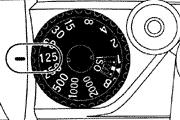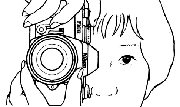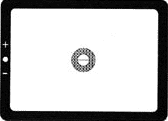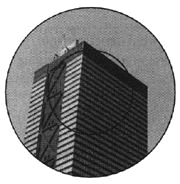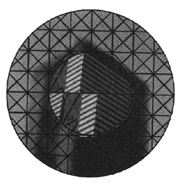Exposure Setting ( Shutter Speed priority )
1. Place the film advance lever (3) in the ready position and turn the shutter speed dial so that the indicator white line aligns with the desired shutter speed value.
|
|
Then if the dial is set at the intermediate positions of the index, shutter speed will be incorrect. Be sure that the dial clicks at the position where the white line aligns with the desired value. With setting at "B" (bulb) position, exposure monitoring is impossible. |
| 2.
With brighter subjects, fast moving subjects or with the higher value film speed
of the film used, it is recommended to use higher shutter speeds. 3. In photography using, telephoto lenses, use the highest shutter speed possible to avoid camera shake affecting your pictures. Generally selecting a higher shutter speed value than the focal length of the lens is recommended, i.e. 1/250s shutter speed is recommended for a telephoto lens with 135 mm focal length, and 1 /500s for 300 mm focal length. |
|
4. Recommended shutter speed with ISO 100/21° film and standard 35-70 mm focal length lens under typical situation is as follows.
|
Subject |
Shutter speed |
|
|
Stationary
subjects |
1 to 1/15 |
|
|
Indoors in normal conditions |
1/30 to 1/60 |
|
|
Outdoors on a fine day |
1/125 to 1/250 |
|
|
Seaside in midsummer |
|
|
|
Mountain area with snow |
||
|
Fast moving subjects |
||
5. To monitor exposure, lightly press the shutter release button (2) and turn the aperture ring (13) until the green "O" mark lights in the viewfinder. When the red "+" mark lights, it means over exposure. So turn the aperture ring in the direction of greater f/value. If the red "-" mark lights, it means under exposure, so turn the aperture ring (13) to a smaller f/value.
Note: Outside the exposure metering range of your camera (EV2 to EV19), the exposure meter will not function properly and the green LED indicator may come on indicating incorrect exposure.
Exposure Setting (
Aperture Priority )
1.
Place the film advance lever (3) in the ready position and turn the aperture ring
(13) until the index on the lens barrel indicates the desired f/ value.
2. The suitable aperture value changes according to the brightness of the
subject, the depth-of-field desired or filmspeed of the film in use, and typical
reading of the aperture with ISO 100/21° film are as follows:
|
Subject |
F/value |
|
| In subdued light |
F/1.4 to F/2 |
|
| To narrow depth-of-field | ||
| Indoors in normal conditions |
F/2 to F/4 |
|
| Outdoors on a cloudy day |
F/4 to F/8 |
|
| Outdoors on a fine day |
F/8 to F/11 |
|
| Seaside in midsummer |
F/11 to F/16 |
|
| Mountain areas with snow | ||
3. To monitor the exposure, press the Exposure measurement button (18) and turn the shutter speed dial until the green O mark lights in the viewfinder. It the red "+" mark lights, turn the shutter speed dial to the higher shutter speed setting and if the red "-" mark lights, then turn the shutter speed dial to the lower shutter speed setting. When the green "O" mark lights at intermediate positions between click, first set the dial at a click on either side and make fine control by operating the aperture ring afterwards.
Note: Outside the exposure metering range of your camera (EV2 to EV19), the exposure meter will not function properly and the green LED indicator may come on indicating incorrect exposure.
Multiple Exposure Photography
|
|
The Multiple Exposure capability is a creative option used to take several different images on the same film frame. |
1. Press the Shutter Release Button to make the first shot.
2. Turn the film advance lever, while turning the Multiple Exposure Lever toward you. Frame Counter will not advance during multiple exposure photography.
3. Press the Shutter Release Button to make the second shot. Repeat the process of No. 2-3 for as many times as you want.
* If you touch the multiple exposure lever while winding the film by turning the film advance lever, the multiple exposure mechanism may be activated.
Holding Camera
|
|
|
| 1.
Hold the camera in the palm of the lett hand so as to turn the lens focusing ring
(15) easily with fingers. 2. Hold the camera body lightly by hand grip (6) and place your right fore finger lightly on the shutter release button. |
3.
Press your left elbow lightly against your body and look through the viewfinder eyepiece
(19) to steady the camera against your face. Then relax your right arm holding the
grip. 4. With telephoto lenses or lower shutter speeds, it is recommended to use a tripod and/or cable release. |
Focusing
1.
Focusing is done by observing through the circled area in the center of the viewfinder
screen. Within the circle is the split image spot prism and around the circle there
is the microprism collar.
|
|
2. In focusing through the split image spot, when the image divided horizontally is brought into alignment by focusing, focus in correct. When the upper-and lower-half images do not align, it is outof -focus. |
3. To focus through the microprism collar outside center spot, a broken shimmering image is seen when it is out-of-focus and correct focus is at the setting in which the image becomes clear and sharp.
|
|
|
| 4. Focusing through the entire matte field of the viewfinder is also possible. In this case, at the setting where the sharpest image is obtained, precise focusing is secured. | Choose the most effective focusing method from the above that you are most comfortable with or according to the shooting situation, such as the lens used, the subject, etc. |
Note: The FM10
viewfinder covers approx 92% of the image area of the actual photograph so the actual
picture comes out larger than the image in the viewfinder.
| Previous | Next | 2/3 Other Useful Features and general camera
care and maintainance
Other Issues relate on FM-10.
| Back | Index Page of Nikon FM-10
| Back |
Main Index Page of Nikon FM Series Models
| Back | to Index Page of FM-10
| Back
| to Main Index
Page of FM Series Models
| Message Board | for
your favourite Nikon
FM Series SLR models
| Message
Board | for your Nikon
Optics in a shared environment
| Message Board | Specifically for Dispose or Looking for Nikon/Nikkor
Photographic Equipment
Standard
production Nikon FM Series models:-
Nikon FM | Nikon FM2 | Nikon FM2n | Nikon FM10 | Nikon FM3a |
Known
variants:-
Nikon
FM Gold
| Nikon
FM2/T
| Nikon
FM2N Tropical Set
| Nikon
FM2/T Limited Edition
| Nikon
FM2N LAPITA
|
Nion
FM2n Millennium 2000
Shared Resources: MD-11 | MD-12 | Focusing Screens | Titanium Shutter | Flash Units -SB-16 | SB-15 | SB-10 or other Options | Databack | Nikkor lens mount (related info)
Others:- Nikon AF-TTL Speedlights | SB-20 (1986) | SB-22 (1987) | SB-23 | SB-24 (1988) | SB-25 (1991/2) | SB-26 (1994) | SB-27(1997) | SB-28 (1997) | Nikon SB-29(s) (2000) | Nikon SB-30 (2003) | Nikon SB-600 (2004) | Nikon SB-800 (2003) Nikon AF-TTL Speedlight DX-Series: Nikon SB-28DX (1999) | SB-50DX (2001) | SB-80DX (2002)
Nikon
BC-flash Series |
Original
Nikon Speedlight
SB-2
| SB-3
| SB-4
| SB-5
| SB-6
| SB-7E
| SB-8E
| SB-9
| SB-E
| SB-10
SB-11
| SB-12 | SB-14 | SB-140 UV-IR| SB-15 | SB16A | SB-17 | SB-18, SB-19 | SB-21A (SB-29) Macro flash | Flash Accesories | SF-1
Pilot Lamp
Instruction
Manual: Nikon FM (HTML | PDF) | Nikon FM-10 (HTML) | Nikon FM2n's
User's Manual
available only in HTML format (6
parts) | Nikon
FM3A
(HTML)
Specifications: Nikon FM, FM-10, FM2, FM2n and FM3A / Main
Reference Map: (HTML) Nikon FM, FM2, FM-10, FM2n (Applicable
to FM2T, FM2 "Year of the Dog"; Millennium 2000") and Nikon FM3A
| Nikon F | Nikon F2 | Nikon F3 | Nikon F4 | Nikon F5 | Nikon F6 | Nikkormat / Nikomat | Nikon FM | Nikon FE/ FA | Nikon EM/FG/FG20 | Nikon Digital SLRs | Nikon - Other models |
Nikon Auto Focus Nikkor lenses:- Main
Index Page
Nikon Manual Focus Nikkor lenses:- Fisheye-Nikkor Lenses - Circular | Full Frame |
Ultrawides Lenses - 13mm15mm18mm20mm | Wideangle Lenses - 24mm28mm35mm | Standard Lenses - 45mm 50mm 58mm | Telephoto
Lenses - 85mm105mm135mm180mm & 200mm | Super-Telephoto Lenses - 300mm 400mm 500mm 600mm 800mm 1200mm |
 Index Page |
Special
Application lenses: Micro-Nikkor Lenses - 50mm~55mm -60mm 85mm -105mm 200mm Micro-Zoom 70-180mm Perspective Control (PC) - 28mm 35mm PC-Micro 85mm Dedicated Lenses for Nikon F3AF: AF 80mm f/2.8 | AF 200mm f/3.5 EDIF Depth of Field Control (DC): 105mm 135mm Medical Nikkor: 120mm 200mm Reflex-Nikkor Lenses - 500mm 1000mm 2000mm Others: Noct Nikkor | OP-Nikkor | UV Nikkor 55mm 105mm | Focusing Units | Bellows-Nikkor 105mm 135mm Nikon Series E Lenses: 28mm35mm50mm100mm135mm | E-Series Zoom lenses: 36~72mm75~150mm70~210mm |
MF Zoom-Nikkor Lenses: 25~50mm | 28~45mm | 28~50mm | 28~85mm | 35~70mm | 36~72mm E | 35~85mm | 35~105mm | 35~135mm | 35~200mm | 43~86mm | 50~135mm | 50~300mm | 70~210mm E | 75~150mm E | 80~200mm | 85~250mm | 100~300mm | 180~600mm | 200~400mm | 200~600mm | 360~1200mm | 1200~1700mm
Tele-Converters: TC-1 | TC-2 | TC-200 | TC-201 | TC-300 | TC-301 | TC-14 | TC-14A | TC-14B | TC-14C | TC-14E | TC-16 | TC-16A | TC-20E
Recommended links to understand more technical details
related to the Nikkor F-mount and production Serial Number:
http://rick_oleson.tripod.com/index-153.html by: my
friend, Rick Oleson
http://www.zi.ku.dk/personal/lhhansen/photo/fmount.htm by: Hansen,
Lars Holst
http://www.mir.com.my/rb/photography/hardwares/nikonfmount/lens2.htm
http://www.photosynthesis.co.nz/nikon/serialno.html
W A R N I N G: The New G-SERIES Nikkor lenses have no aperture ring on the lens, they CANNOT ADJUST APERTURES with any of these manual focus Nikon FE series SLR camera models; please ignore some portion of the content contained herein this site where it relates.
|
Back | Main Index Page of Nikkor Resources
|
Back | Main Index Page of Pictorial
History of Nikon SLRs
| Message Board | for your Nikkor optics ("shared" because I do wish some of you to expose to other's perspective as well. Isn't it a sad sate to see photography has to be segmented into different camps from the use of various labels)
about this photographic web site
Home - Photography in Malaysia |
Credit: To all the good people who has contributed their own experience, resources or those who are kind enough granting us permission to use their images appeared in this site. Mr. MCLau®, who has helped to rewrite some of the content appeared this site. Chuck Hester® who has been helping me all along with the development of all these Nikon websites;LarsHolst Hansen, 'Hawkeye' who shares the same passion I have; Ms Rissa, Sales manager from Nikon Corporation Malaysia for granting permission to use some of the official content; TedWengelaar,Holland who has helped to provide many useful input relating to older Nikkor lenses; Some of the references on production serial numbers used in this site were extracted from Roland Vink's website; HiuraShinsaku from Nikomat Club Japan. t is also a site to remember a long lost friend on the Net. Note:certain content and images appeared in this site were either scanned from official marketing leaflets, brochures, sales manuals or publications published by Nikon over the years and/or contribution from surfers who claimed originality of their work for educational purposes. The creator of the site will not be responsible for may discrepancies arise from such dispute except rectifying them after verification."Nikon", "Nikkormat", "Nippon Kokagu KK" & "Nikkor" are registered tradename of Nikon Corporation Inc., Japan. Site made with an Apple IMac.
